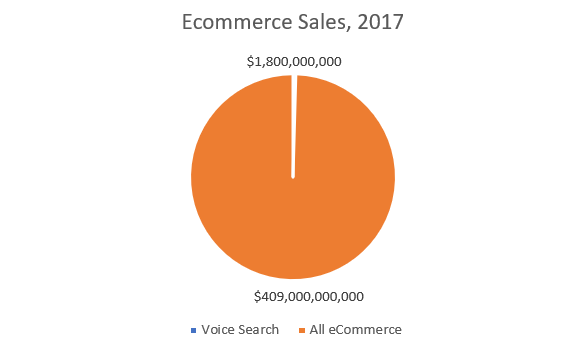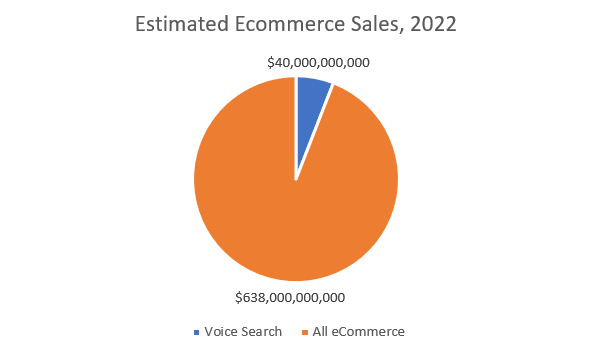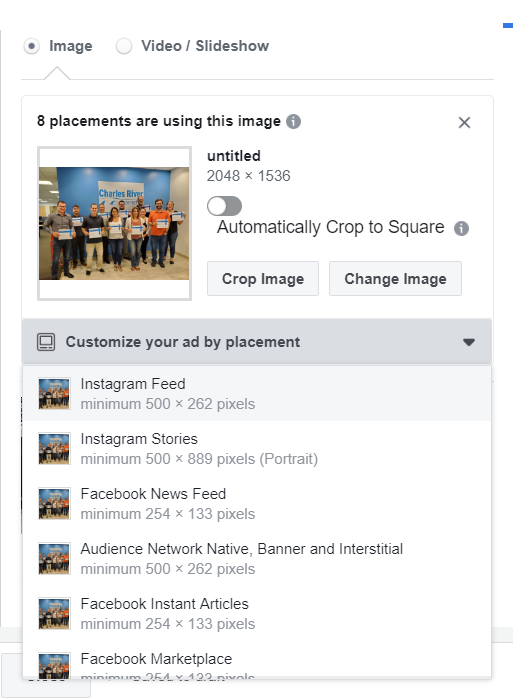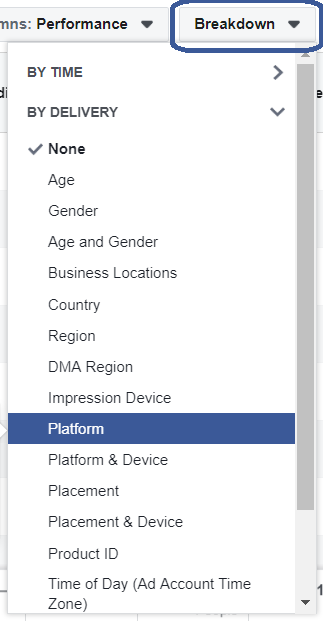by Charles River Interactive | December 17, 2019 | Uncategorized
The short answer: No.
When developing a social media marketing strategy, one of
the first decisions you need to make is which platform to advertise on. And
when it comes to Facebook vs. Instagram, there’s an additional layer of
complexity to the question, because ads for both platforms are run through the
same system in Facebook’s Ads Manager. Ads Manager gives users the option of
either keeping their Facebook and Instagram strategies separate, or running
campaigns across both platforms simultaneously. I’ve seen a lot of confusion about
this among people who aren’t familiar with the space, so I’m going to try to
clear things up a little bit and explain why, when deciding whether to run your
ads on Facebook or on Instagram, you will almost always see the best results
when the answer is “both”.
Why You May Be Tempted to Keep Facebook & Instagram Ads Separate
As a user, Facebook and Instagram are two very different
social networks, and they each have distinct user experiences, cultures, and demographics.
This can lead advertisers to believe that the best way to organize their
advertising strategy and maximize performance is to develop separate campaigns
for Facebook and for Instagram, with ads specifically designed to run on one
platform or the other. Another reason advertisers may decide to separate their
campaigns by platform is to test performance to determine which platform is
most effective for them, so that they can run their ads only on the platform
that performs the best. In theory, both of these strategies sound like good
ideas and seem to be logically sound. However, in practice, they conflict with
Facebook’s built-in optimization features and can diminish overall results.
Why You Will See Better Performance Running Ads to Both Platforms
Simultaneously
It’s helpful to think of it this way: with Facebook’s Ads
Manager, ads aren’t being delivered to the platform, they’re being delivered to
the person. When determining when and where to serve your ads, Ads Manager
prioritizes reaching the right people (users who match your targeting criteria
and are likely to engage positively with your ad) wherever they may be.
Say, for example, there is a user who matches your perfect
customer profile who logs into Facebook 4 days out of the week and logs into Instagram
the other 3 days. Each day, your ads enter the auction with the goal of serving
to this perfect customer. However, if your ads are only running on one of the
two platforms, you will only have the opportunity to reach this customer 40-60%
of the time. The rest of the days, your ads will serve to slightly
lower-quality prospects, because your perfect customer was not online on the platform
that the ads were serving to. This remains true whether you have only one
campaign running to a single platform, or multiple campaigns running to each
platform separately. In contrast, if your strategy allows Ads Manager to run
your ads to both Facebook and
Instagram, your ads will be able to serve to the optimal person 100% of the
times that they are online.
How You Can Optimize By Platform Without Keeping Them Separate
Ads Manager includes two important features which enable
advertisers to understand how the different platforms are performing and
optimize for each without keeping ads confined to only run on a single platform.
The first helpful feature is an option in the ad building tool which allows you to customize your ad based on placement. This tool enables customization of the media and text for any given ad, based on where that ad will be served. For example, if you want to run an ad on both Facebook and Instagram, but you want to use different image dimensions for the two platforms, you can use this tool to customize the image so that the version of the ad that appears on Facebook has a rectangular image, and the version that appears on Instagram has a square image. This allows advertisers to match their ad content to each platform without breaking up their strategy and keeping the platforms completely separate.
Customize by Placement – Placement Options
The second feature which enables advertisers to optimize by platform is the performance breakout capabilities available in reporting. Ads Manager can break down performance data (spend, impressions, clicks, etc.) across a number of different dimensions, including ad placement. This means that regular reports and performance check-ins can include comparing performance across platforms at a number of different levels. You can see which platform is driving the best KPI results overall, whether particular audiences may be more likely to convert on one platform versus the other, and you can even see if any individual ads resonate better on a particular platform. This provides a huge volume of valuable insights into how users engage with your ads and enables advertisers to extract key learnings about the differences between the platforms without needing to sacrifice efficiency for the sake of keeping the data separate.
Customize by Placement – Customization Options
Performance Breakdown Options
In Conclusion
Although it’s understandable to think that the only way to effectively manage ads across these two different platforms is to keep them separate, there are great optimization opportunities and insights available, even without splitting up your strategy. And, ultimately, overall performance is a game of averages, and for the reasons discussed above,shutting down or separating out one platform entirely – even if it looks like it’s under-performing compared to the other – will often hurt your average.
by Charles River Interactive | May 14, 2018 | Industry Trends, Local SEO, Organic Search, SEO, Uncategorized
“Alexa, order floor mats for my Honda Pilot.”
“OK Google, find me a place for tacos right now.”
“Hey Siri, when is World Immunization Week?”
Voice search is more and more a part of our everyday lives. As the technology becomes more commonplace, and as developers expand the number and types of actions you can complete using just your voice, the opportunities for businesses grow and change on a seemingly daily basis.
We’ve written about optimizing for voice search before; here is what we have learned since in preparing our clients for a mobile, screen-less future in search.
Who Uses Voice Search?
- 30% of web browsing sessions will be screen-less by 2020, according to Gartner
- Voice search usage skews heavily toward Millennials—more than 1 out of 3 Millennials do or plan to use a voice-search aided virtual assistant, as compared to just 1 out of every 10 members of the Baby Boomer generation, according to eMarketer
- Millennials are more likely to use voice search in part because they are the largest group of owners of a smart home device, according to Walker Sands
- Younger demographics are more likely to use voice search on a mobile device, according to Global Web Index—25% of users ages 16-24 reported having used a voice search tool on their mobile device in the last month
Why Voice Search?
It is possible to predict why a user might choose to search via voice based on readily available information such as device and location.
Mobile Voice Search is Local SEO
Voice searches originating on a mobile device tend to be location-dependent—that is, users typically search for strings such as, “[service] near me”, or “nearby [product]”.
The optimal strategy for capturing traffic from these voice searches has not changed much since its debut. We know that Google voice search, for instance, relies on structured data of the sort that drives the appearance of featured snippets but which explicitly includes location and other relevant information, such as hours. A thorough local SEO strategy should be sufficient to ensure that your site is positioned to capture such traffic. If you’re not sure if your business or website is already capitalizing on local SEO opportunities, reach out to us!
Smart-home Voice Search is an Ecommerce Opportunity
According to data published via Statista, the general retail ecommerce sector in the US economy is estimated to have totaled over $409 billion in sales in 2017, and is forecast to surpass $638 billion by 2022. Voicebot.ai, meanwhile, pegs the US retail ecommerce voice search market currently as a $1.8 billion segment—a figure expected to rise to $40 billion within the next five years.
Voice search may comprise only a small portion of the retail ecommerce sector at the moment—0.44%, according to the above estimates—but that segment is growing faster than the overall ecommerce sector. Based on the above figures, by 2022, voice search will be component in 6.27% of all ecommerce transactions. The pie is growing, and this slice is growing even faster!


The retail ecommerce pie is growing, and the voice search slice is growing even faster!
The largest share of voice search ecommerce transactions are initiated via a smart-home device. According to GeoMarketing, 82% of Amazon Echo/Dot owners subscribe to Amazon Prime. That fact facilitates roughly two-thirds of purchases, all of which can be categorized as staples—groceries, entertainment, electronics, and clothing.
This represents both an opportunity and an obstacle. Customers are comfortable purchasing staples sight unseen. “Alexa, order Bounty paper towels” is a lot different from “Alexa, order floor mats for my new car.” Shoppers want to discover new products visually; voice search—absent broader integration into a smart home—may not be the right method for that, or one that we would expect users to adopt.
If we are to prepare for a future where shoppers expect to discover and shop for new or novel products via voice search, we likely do not need to significantly alter our strategies. A recent Search Engine Land article laid out what might be over and above what we consider SEO best practices—a list that starts and ends, for most ecommerce retailers, with the suggestion to optimize content for conversational keywords.
Ecommerce and Long-tail Keywords
Conversational keywords can be understood as phrases and complete sentences. Consider the example above—“OK Google, order floor mats for my Honda Pilot.” We would expect a search engine to parse this as “floor mats” + “Honda Pilot”, with search intent clearly aligned around purchasing as opposed to information or research. We would expect a traditional search engine results page to be populated with product pages; we also would expect to see a Google Shopping grid on the right-hand rail. And, what do you know:

An example of a Google SERP for a long-tail, purchase-motivated search query
Our clients’ sites have gained qualified, purchase-ready traffic with holistic content strategies. By aligning the informational blog posts or evergreen articles with custom product descriptions, we have been able both to improve the average position for target keywords and to increase the total number of keywords for which the page ranks (and, over time, ranks well).


A holistic SEO content strategy maximizes content production beyond the initial article
Many sites assume that blog posts and evergreen articles are the extent of their content production. We have found that nothing could be farther from the truth—in fact, the initial blog post really is the point of origin. Like a radio signal, it spreads across your site via the pages to which it links, and in turn the pages to which they link.
By selecting, for instance, to link to a product with several related products displayed beneath, rather than linking to a dead-end product page, we accomplish a primary eCommerce SEO goal, linking to multiple product pages within three clicks of the homepage.
By writing expanded descriptions on those product pages, we are able to more fully educate search engines as to what products we sell, who might be interested in them, and for what they might be used. In a nutshell, this is semantic SEO.
This type of content is fantastic if you are adhering to Google’s stated mandate—that you design your site to satisfy the user’s intent. Through the lens of voice-search optimization, however, there has to be another side to the coin.
Structured Data
The virtual assistants powering voice search—Alexa, Siri, The Google Assistant; pick your poison—are designed to interpret natural speech. It is possible that, over time, they will be able to crawl, read, and understand normal content with the same level of comprehension as a typical internet user. In the interim, however, we can look at what we know about where virtual assistants find the information they repeat back in response to a voice search.
A recent Backlinko study considered 10,000 Google Home search results. The study includes plenty of valuable insight; here are our 3 key takeaways:
- 41% of voice search answers came from a featured snippet
- The average answer came from a page with a word count well over 2,000
- Very few results had the exact query in their title tag
Each of the above supports the advice we have given our clients on this topic. Featured snippets are important, and there are steps you can take to encourage Google to display information from your site in the knowledge panel, but Google themselves have shown a clear preference for high domain authority sites in this regard, in particular. The best you can do is prepare and develop your site in such a way that it is possible for Google to build a snippet, should they decide doing so is the best way to address a user’s query.
Of course, a featured snippet is not the only use for structured data on your site. And here, we see some of the greatest potential for growth across the voice search ecommerce landscape. Amazon, Apple, and Google all may want to develop their virtual assistants to the point where they easily can parse relevant text out of long-form content—but, in the interim, and if the goal is to answer a user’s ecommerce-related voice search, we can expect them to use the most accurate information available that their respective spiders can readily digest. And that, for now and the foreseeable future, is structured data.
Articles can be associated with the Question schema. There is a product schema, and there is no shortage of additional structured data types, objects, and properties that can be built out for most pages—images, alternative names, prices, dimensions, many of which also have particular machine-readable formats that improve search engines’ understanding of your site.
Optimizing for voice search is little different from optimizing for organic search. One key to success is understanding how voice search engines consume and synthesize information—and how you can use that knowledge to your advantage. Long-form content that thoroughly addresses a search topic paired with structured data highlighting certain questions-and-answers, and extends across the network of interconnected product pages, has proven to be effective for us in achieving growth for our clients.

by Charles River Interactive | February 2, 2018 | Organic Search, SEO, SEO Blogs, SEO Industry Trends, Uncategorized
Super Bowl LII takes place this Sunday, February 4th at 6:30pm in Minnesota. Last year, more than 111 million viewers watched Super Bowl LI and the incredible comeback of the New England Patriots over the Atlanta Falcons. It can be expected that a similar number of viewers will tune in again this year as the Patriots battle the Eagles for what could be their 6th Super Bowl win.
Although actually watching the Super Bowl is the most important event this upcoming weekend, personally, I find that the food during the Super Bowl is just as important to the overall experience.
In my house, during football season, there’s always something “buffalo chicken” related, whether it be wings, tenders or a nice dip (my favorite). But, what about outside of my house? Which is most popular? To find my answer, I went to right to the source: Google. What is the most searched for buffalo chicken snack form during the week leading up to Sunday’s game? Looks like the Internet is with me because “buffalo chicken dip”, in red, has historically been the most popular of the “buffalo chicken” related snacks leading up to the Super Bowl:

Blue Cheese or Ranch with your buffalo chicken?
Fortunately, or unfortunately, with “buffalo chicken…”, in my house, comes the debate ranch or blue cheese. I was hoping to finally put an end to this debate and prove the blue cheese was the favored pairing, by researching average monthly search numbers using Google Adwords. Unfortunately, my research proved me wrong.
Comparing the query “ranch recipes” to “blue cheese recipes”, ranch outnumbered blue cheese by an average of 700 monthly searches, according to Google Adwords. Even the trend for these searches proved me wrong! “Ranch recipes” are more popular during AFC and NFC Championships and Super Bowl weekend than “blue cheese recipes”.

Based on that information, looks like I’ll be making a buffalo chicken dip with ranch instead of blue cheese mixed in.

Who wants to be healthy on Super Bowl Sunday?
Turns out, a lot of people do. As did many Americans, I set a goal to get healthier in 2018. Obviously, buffalo chicken dip with ranch dressing is definitely not the way to go about doing that. Lucky for me, I’m not the only one looking for either healthy or good Super Bowl snacks! Interestingly enough, looking at Google trends, the query “healthy super bowl snacks” has seen a 50% rise in search queries since last Super Bowl weekend. Looking at January and February 2017 average monthly searches for “healthy super bowl snacks”, the query had 1.2 million and 1.8 million searches, respectively.
Looking for inspiration to make some healthy super bowl snacks along with your buffalo chicken dip? The following websites are holding the top spots in search results:
Let’s not forget about those 3 million American’s who have celiac disease that need a gluten-free option to indulge in during the Super Bowl. Although queries surrounding “gluten-free super bowl snacks” range from 10 to 40 average monthly searches, according to Google Adwords, the following websites hold the top spots in search results for these treats:
Gluten-free or not, healthy snacks or buffalo chicken dip, I know I can’t wait until game time to watch Super Bowl LII and munch on some yummy treats, no matter what they are. Oh, ya, and Go Pats!

by Charles River Interactive | November 10, 2016 | Content Marketing, Industry Trends, Uncategorized
Stakeholders are a necessary component of nearly every content project. Without their unique perspectives, even the most talented writers and strategists would fall short of creating the best, most customized product possible.
As a result, they are incredibly important and impactful players– and not only because of their unmatched expertise and invaluable feedback. Stakeholders have the ability to:
- Delay or halt projects
- Change direction or process
- Impact budget or scope
- Approve the final product or …
- Send everything back to the drawing board
You can’t live with them, and you can’t live without them. That’s why all marketers should follow this advice: When it comes to stakeholders, handle with care.
Common Stakeholder Problems
Whether you are a client working with internal stakeholders or a marketer who regularly manages them, the challenges are the same. You may have encountered setbacks or challenges from any of these common personalities:
- The Break Pad: These stakeholders have jam-packed schedules and may be repeat “no-shows” for interviews. They sit on content for weeks past deadline, holding the review process hostage. It’s a common situation because the most valuable stakeholders often hold very senior positions and are legitimately busy.
- The Charlie Brown: Everybody on the project wants these people to weigh in, but they do not understand their value. Interviews are challenging because they don’t provide clear, direct answers or often defer to other people, who may or may not be stakeholders. As a result, their feedback is light on the key details you need.
- The Expert: While all stakeholders are experts in their areas, this stakeholder is also an expert in your job – whether it’s writing content, developing an SEO strategy or designing a webpage. It may be hard to convince this stakeholder of well-accepted industry best practices if he or she disagrees. Prepare for intense edits and feedback.
- The Monday Morning Quarterback: The no. 1 reason for project delays? Either the Charlie Brown or The Expert can morph into this stakeholder in the final stages. They see the first draft and disagree with its direction, possibly even contradicting their own input. Be aware: It’s very common for stakeholders to change their mind or be surprised when they see their words spun into something more tangible like a webpage or blog.
Best Practices for Managing Stakeholder Relationships
The best way to work with stakeholders is a very proactive approach. We have compiled our best practices for interviewing and managing stakeholders to help avoid those frustrating project delays and setbacks:
- Establish a clear process from Day 1: Put yourself in the uninformed stakeholder’s shoes: They do an interview with you or your team, you disappear for weeks, then re-emerge with a sudden need for feedback and approval at a time that may not be convenient. You would be annoyed, too, right? Take a few minutes during your stakeholder call to walk them through the process, timeline and what you will need from them so they are prepared.
- Don’t be afraid to over-prepare: If you want to get the most out of your stakeholder interview, do not show up as a blank slate. Do your homework by researching as much as you can about the subject matter, client, competitors and even the stakeholder ahead of the interview. Asking basic questions is the best way to waste an interview. Instead, use your time to delve deeper and get into messaging, differentiators and help with more complex topics.
- Communicate key dates and repeat, repeat, repeat: Stakeholders are very busy. They will quickly scan your email, so make it easy for them: Clearly state your time frame in bold font. At your interview, remind them at the start and end when they will receive a draft for review. Follow up with an email reminding them of this date and how much time they will have for feedback. Send reminders ahead of the deadline.
- Avoid sending a list of questions in advance: It may sound counter-intuitive. But if you want the most out of your discussion, don’t fence yourself in with a script. When given a list of questions, stakeholders tend to offer stiff, careful answers. You miss out on the rich details that a more organic conversation can uncover. Instead, provide an overview of topics and write a few short sentences describing your goals for the interview.
- Control the review process: Lay the groundwork for a clear review process before scheduling the first stakeholder call. If you are working with multiple stakeholders, it’s a good idea to establish the following:
- Which stakeholders need to review/approve the final product, and whether anyone’s feedback is more authoritative or should be last
- How many rounds of revisions are included within project scope
- Whether stakeholders are editing for content, accuracy, messaging, or all of the above
- A process for ensuring consolidated feedback so you don’t get back conflicting feedback and direction
- A clear timeline and how feedback delays will affect project completion
Interested in learning more about content marketing? Check out Charles River Interactive’s blog View from the Charles:
7 Email Marketing Best Practices
How to Write Strategic Calls to Action
5 Tips for Writing for Mobile
Want more information? Get more details on Charles River Interactive’s SEO and PPC service offerings or contact us today.
by Charles River Interactive | September 22, 2016 | Content Marketing, Uncategorized
Email marketing has been around since, well, probably almost as long as emails have existed. And, why not? Email is another channel with which to communicate, so using it as a marketing medium makes a lot of sense.
The difference between email marketing and plain old emails is that plain old emails from a friend or colleague are not intrusive, or at least they shouldn’t be. Email marketing can be. So, email marketing has evolved over time to address issues that we, as recipients, don’t appreciate, and that we as marketers need to respect.
As a marketer, keep these email marketing best practices in mind when creating and sending emails to your recipients.
1) Send emails to a list of people who have agreed to receive information from your company.
Marketing emails are considered to be “spam” if sent to someone who has not opted in to the list (directly or through a 3rd party). Marketers can get in trouble if sending “spam” emails, or emails that the recipient has not agreed to receive. So, make sure—before you send emails to a list—that the list has opted in to receive information from your company, or you are marketing via a legitimate 3rd party list that people have opted into.
2) Know your audience and be respectful.
Email marketing should offer something of interest and value to your recipient. An invitation to an event, an offer to receive a product discount, complimentary information, or a discount, something that you know they would like and respond well to. Make the offer (also referred to as the “Call to Action”) clear so it’s obvious what you are asking of your recipients.
3) Write engaging subject lines.
The best subject lines are the ones that get people to open the email, assuming you aren’t being deceptive or sneaky with your subject line. Some folks say short is the way to go; others opt for longer subject lines. I love subject lines that are questions. Good questions draw in the reader. A subject line like: “Want to know the #1 mistake every company makes?” would grab my attention. Or, make the subject line super direct: for example, when offering content, make the subject about what someone can take away from reading this email, e.g., “The top 5 mistakes every company makes”.
4) Determine the sender.
If you don’t have your own database of email recipients, or your company is new and no one knows it, you should consider using a 3rd party list with a well-known name that allows sponsors (advertisers) to send a marketing email to their list. (You don’t get access to the list; you send your email to the company that sends it out on your behalf.) Think of it this way: if The New York Times is sending out your email to their subscriber list (who have agreed to receive 3rd party information), then the likelihood of the recipient opening that email is much higher than if the sender is “No Name Co.”. Also, think about whether the email sender should have a person’s name vs. the company name. Different approaches work based on what the content is.
5) Keep mobile in mind, always.
Many people are viewing emails on their mobile devices and that trend is only growing. For those reading emails on their SmartPhones, you need to keep the snippet text (aka preview text or preview header) relevant—it’s the blurb that summarizes what the email is about and is viewable after the subject line. If the subject line is interesting and the snippet text is relevant, you will get more opens. Another thing to keep in mind: if your emails include graphics, you want the graphics to download quickly; this is super important with mobile users.
6) Timing in life is everything, right?
It used to be that companies wouldn’t send marketing emails after work hours or on weekends. Now that people are viewing their emails on their devices around the clock, you may cut through the clutter in the evening or on weekends. Test your send times to see when you get the best open rates.
7) Last, but most importantly, think like your customers and prospects.
If you wouldn’t like, read, or respond positively to an email that you are about to send to your list, it’s likely your recipients won’t either. (This ties back to the “be respectful” comment above.) Be clear about what you are asking of them. Make it easy for them to learn more about your business, your offerings, and most of all, make it really easy for them to buy from you. After all, that’s what marketing is all about.
Interested in learning more about email marketing? Read more from our blog, View from the Charles:
5 Tips for Writing for Mobile
How to Write Strategic Calls to Action
by Charles River Interactive | September 13, 2016 | Organic Search, Uncategorized
Implementation is one of the toughest challenges any SEO consultant faces. That’s because making many of the key changes we recommend takes an investment of time, resources and planning from the client.
The most successful client engagements develop from a true partnership among teams, including the SEO consultants and account managers working closely with client-side project managers, developers and key stakeholders.
We make customized recommendations based on your product, target audience and marketing goals, and then continue to support you throughout implementation as needed. In some cases, the CRI team can even implement the recommendations for you.
Roadblocks to SEO Implementation
However, as client managers, it’s important for us to understand that it’s not always an easy process.
There are a number of reasons that could prevent clients from implementing SEO recommendations:
- The CMS may not be as easily customizable as the client team initially believed.
- There may be a lengthy approval process that recommendations need to go through first.
- The website may be in line for a redesign and the webmaster is pushing back with making any updates before the refresh launches.
Often, it’s simply a resource issue that puts SEO recommendations on the back-burner.
The Importance of Prioritizing SEO Implementation
While all of these are valid, keep in mind the following:
- Without making any major updates to the site, you can’t expect the results that you’re trying to accomplish. It’s very important to understand that implementing recommendations is crucial to any SEO program success.
- It does take time with search engines to register your site’s updates. So, the sooner you implement the SEO recommendations, the sooner you will see a boost in performance.
- Testing things out can lead to more effective strategy and tactics. What makes paid search so flexible and powerful is the ability to constantly test the ad copy to determine what brings the highest click-through rate at the lowest cost. Of course, organic optimization is completely different and you won’t be able to see the same results in the same timeframe as with a PPC campaign. However, implementing SEO recommendations quickly, monitoring performance and adjusting tactics as needed can significantly boost organic results.
Troubleshooting SEO Challenges
Here at CRI, we perform implementations for a number of clients and have seen great success.
When this method is not possible, educating clients on the importance of SEO implementation, explaining potential results and providing competitive examples help the most.
What helps you to make sure the SEO recommendations get implemented? How do you overcome obstacles on this front if there are limitations as to what can be done?
Interested in learning more about trends and developments with Google? Read more from our blog, View from the Charles:
What You Need to Know about Google Symptom Search
Make Google Alerts Work for You













